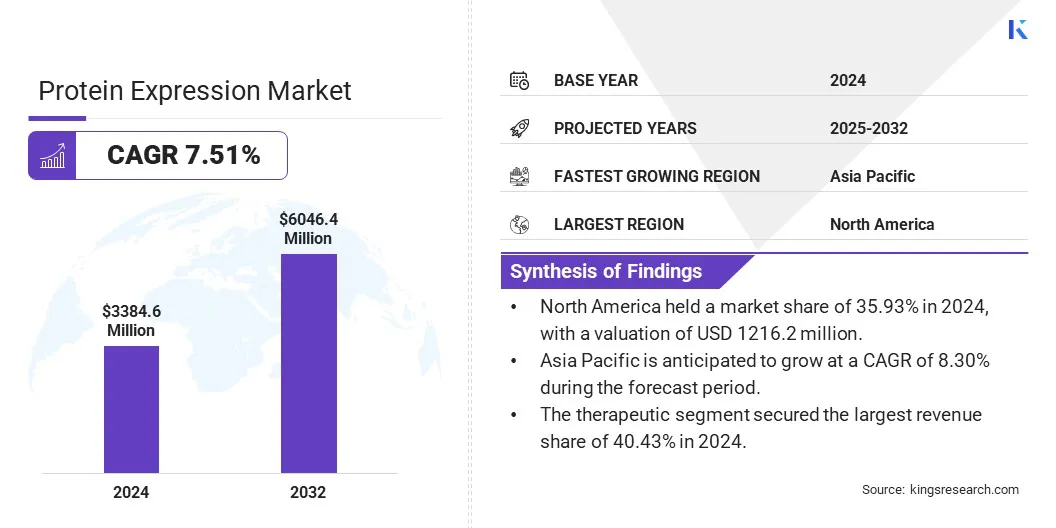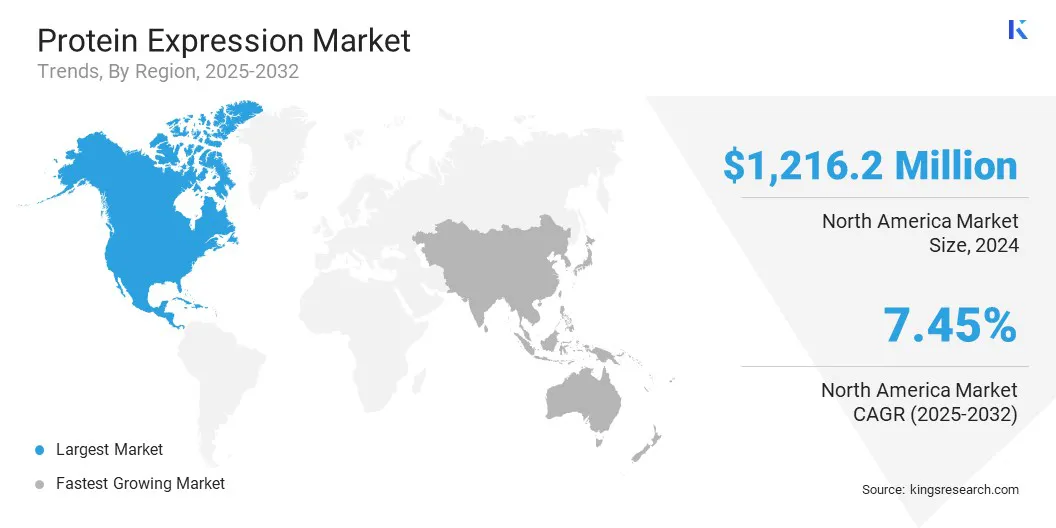Market Definition
The market encompasses technologies, systems, and services that enable the production of recombinant proteins in various host systems, including prokaryotic, eukaryotic, and cell-free platforms. It includes reagents, vectors, and expression systems.
The market serves pharmaceutical, biotechnology, academic, and contract research sectors, with applications in drug discovery, therapeutic protein production, structural biology, and industrial enzymes. The report provides a comprehensive analysis of key drivers, emerging trends, and the competitive landscape expected to influence the market over the forecast period.
Protein Expression Market Overview
The global protein expression market size was valued at USD 3384.6 million in 2024 and is projected to grow from USD 3636.4 million in 2025 to USD 6046.4 million by 2032, exhibiting a CAGR of 7.51% during the forecast period.
The growing prevalence of chronic conditions and advancements in cell-free protein synthesis technologies are driving substantial demand for protein-based therapeutics, thereby accelerating market growth.
Major companies operating in the protein expression industry are Thermo Fisher Scientific Inc., Merck KGaA, GenScript, Bhat Bio-tech India Private Limited., Sino Biological, Inc., New England Biolabs., OriGene Technologies, Inc., QIAGEN, Synbio Technologies, Agilent Technologies, Inc., Abnova Corporation., Syngene International Limited, Takara Bio Inc., Eurofins Scientific, and Charles River Laboratories.
The market is driven by increasing investments in research and development across the biotechnology and pharmaceutical sectors. Increased focus on novel therapeutics, advanced biologics, and vaccine production necessitates efficient protein synthesis systems.
Rising demand for high-yield, cost-effective expression technologies is accelerating product development and clinical applications in protein synthesis. This increase in R&D activity is driving commercial adoption globally, in turn, fueling market growth.

Key Highlights:
- The protein expression market size was recorded at USD 3384.6 million in 2024.
- The market is projected to grow at a CAGR of 7.51% from 2025 to 2032.
- North America held a market share of 35.93% in 2024, with a valuation of USD 1216.2 million.
- The product segment garnered USD 1301.6 million in revenue in 2024.
- The mammalian cell segment is expected to reach USD 1661.1 million by 2032.
- The therapeutic segment secured the largest revenue share of 40.43% in 2024.
- The academic research segment is poised for a robust CAGR of 7.78% through the forecast period.
- Asia Pacific is anticipated to grow at a CAGR of 8.30% during the forecast period.
Market Driver
Rising Prevalence of Chronic Conditions
The increasing prevalence of chronic conditions such as cancer and diabetes is fueling demand for protein-based therapeutics, which offer targeted and effective treatment options.
In response, biopharmaceutical companies are investing in advanced protein expression technologies to enhance therapeutic efficacy and accelerate development timelines, thereby driving the growth of the global market.
- In April 2025, the National Institute for Health Care Management (NIHCM) highlighted the escalating impact of chronic diseases, stating that 90% of the USD 4.5 trillion spent on U.S. healthcare in 2022 was directed toward the treatment of individuals with chronic health conditions.
Market Challenge
Challenges in Membrane Protein Production
A major challenge in the protein expression market is the production of complex membrane proteins, which are critical for drug discovery, diagnostics, and other biotechnology applications. These proteins are difficult to express and purify due to their hydrophobic properties and intricate structures.
To address this, manufacturers are developing specialized expression systems based on insect cells and yeast, which have shown greater efficiency in producing functional membrane proteins. In parallel, advancements in solubilization techniques, detergent formulations, and high-throughput screening are increasing protein yield and stability.
These improvements are enabling more efficient production processes and expanding the use of membrane proteins in pharmaceutical research and development.
Market Trend
Advancements in Cell-Free Protein Synthesis
A key trend shaping the market is the growing shift toward cell-free protein synthesis technologies. This approach is gaining traction due to its ability to produce proteins rapidly and efficiently without relying on living cells. The trend reflects a broader industry movement toward streamlining workflows and accelerating timelines in research and biopharmaceutical development.
As companies seek more flexible and scalable production methods, the adoption of cell-free systems is emerging as a pivotal factor influencing innovation and competitiveness in the protein expression landscape.
- In April 2025, LenioBio GmbH partners with Avantor to expand access to its ALiCE cell-free protein synthesis technology across Europe, enhancing rapid, efficient protein production for research. The collaboration aims to drive scientific progress and support protein expression advancements.
Protein Expression Market Report Snapshot
|
Segmentation
|
Details
|
|
By Component
|
Product (Reagents & Kits, Competent cells, Expression vectors, Instruments), Software, Services
|
|
By System
|
Prokaryotic, Mammalian cell, Insect cell, Yeast, Others
|
|
By Application
|
Therapeutic, Industrial, Research
|
|
By End Use
|
Pharmaceutical and Biotechnological, Academic Research, Contract Research Organizations, Others
|
|
By Region
|
North America: U.S., Canada, Mexico
|
|
Europe: France, UK, Spain, Germany, Italy, Russia, Rest of Europe
|
|
Asia-Pacific: China, Japan, India, Australia, ASEAN, South Korea, Rest of Asia-Pacific
|
|
Middle East & Africa: Turkey, U.A.E., Saudi Arabia, South Africa, Rest of Middle East & Africa
|
|
South America: Brazil, Argentina, Rest of South America
|
Market Segmentation:
- By Component (Product, Software, Services): The product segment earned USD 1301.6 million in 2024 due to the consistent demand for high-quality reagents, expression vectors, and competent cells that are essential for efficient and scalable protein production across research and industrial applications.
- By System (Prokaryotic, Mammalian cell, Insect cell, Yeast, Others): The mammalian cell segment held 27.44% of the market in 2024, due to its ability to produce complex proteins with proper folding and post-translational modifications, which are critical for therapeutic and biopharmaceutical applications.
- By Application (Therapeutic, Industrial, Research): The therapeutic segmnet is projected to reach USD 2421.4 million by 2032, owing to the rising demand for recombinant proteins in the development of biologics and targeted therapies for chronic and infectious diseases.
- By End Use (Pharmaceutical and Biotechnological, Academic Research, Contract Research Organizations, Others): The pharmaceutical and biotechnological segment earned USD 1263.6 million in 2024 due to its extensive investment in research and development for drug discovery, biologics production, and personalized medicine.
Protein Expression Market Regional Analysis
Based on region, the global market has been classified into North America, Europe, Asia Pacific, Middle East & Africa, and South America.

North America protein expression market share stood at around 35.93% in 2024, with a valuation of USD 1216.2 billion. This dominance is attributed to the region's high healthcare expenditure, which drives substantial investment in advanced biopharmaceutical research and development.
The region’s well-established healthcare infrastructure, coupled with strong government and private sector funding, drives the increasing adoption of protein expression technologies. Additionally, the presence of leading biotechnology firms and academic institutions accelerates innovation and commercialization, thereby driving market growth in this region.
- In April 2025, the American Medical Association (AMA) reported a 7.5% increase in health spending in the United States in 2023, reaching USD 4.9 trillion, or USD 14,570 per person. Health expenditures accounted for 17.6% of the nation's Gross Domestic Product (GDP) in 2023.
Asia Pacific is poised for significant growth at a robust CAGR of 8.30% over the forecast period. The growth is driven by expanding biopharmaceutical and biotechnology sectors. Key factors include increased R&D investments, rising demand for advanced therapeutics, and government support.
Additionally, the presence of a skilled workforce and cost-effective production enhance the adoption of protein expression technologies in this region, which further fuels market growth.
Regulatory Frameworks
- In the U.S., the United States Pharmacopeia (USP) establishes quality standards for pharmaceuticals and their components, including biologically derived substances such as recombinant proteins.
- In China, the National Medical Products Administration (NMPA), formerly known as the China Food and Drug Administration (CFDA), is responsible for regulating drugs, biologics, and medical devices. It enforces Good Manufacturing Practices (GMP) for biologics and oversees the approval of protein-based therapeutics through its Drug Registration Regulations.
Competitive Landscape
The protein expression market is highly competitive, with leading players pursuing strategic acquisitions to enhance their technological capabilities and broaden service offerings. Key players are consolidating to streamline workflows, increase global reach, and strengthen proprietary platforms.
These acquisitions are enabling the integration of advanced expression systems and accelerating biologics development. Market consolidation is also fostering vertical integration, optimizing production efficiency and cost-effectiveness. This competitive dynamic is reshaping the landscape, positioning firms for sustained growth and innovation leadership.
- In May 2024, Merck entered into a definitive agreement to acquire Mirus Bio, a life science company focused on the development and commercialization of transfection reagents. The acquisition is intended to strengthen Merck’s position in the field of viral vector production, a critical component in the manufacturing of cell and gene therapies. This transaction aligns with Merck’s broader objective to expand its technological capabilities and support the development and delivery of advanced therapeutic solutions on a global scale.
List of Key Companies in Protein Expression Market:
- Thermo Fisher Scientific Inc.
- Merck KGaA
- GenScript
- Bhat Bio-tech India Private Limited.
- Sino Biological Inc.
- New England Biolabs.
- OriGene TechnologiesInc.
- QIAGEN
- Synbio Technologies
- Agilent Technologies Inc.
- Abnova Corporation
- Syngene International Limited
- Takara Bio Inc
- Eurofins Scientific
- Charles River Laboratories
Recent Developments (M&A/Partnerships)
- In September 2024, Sino Biological and BioGeometry expanded their strategic partnership to advance protein research and development through generative artificial intelligence (AI). This collaboration combines Sino Biological’s cutting-edge protein expression and laboratory capabilities with BioGeometry’s AI-driven protein design and optimization platform.
- In July 2024, Thermo Fisher Scientific completed its acquisition of Olink Holding AB, enhancing its proteomics capabilities. This move complemented its mass spectrometry offerings, enabling global researchers to accelerate discoveries and breakthroughs, while providing significant value to shareholders.
Under this partnership, the companies aim to strengthen their joint solutions and pursue high-value opportunities in global markets.


